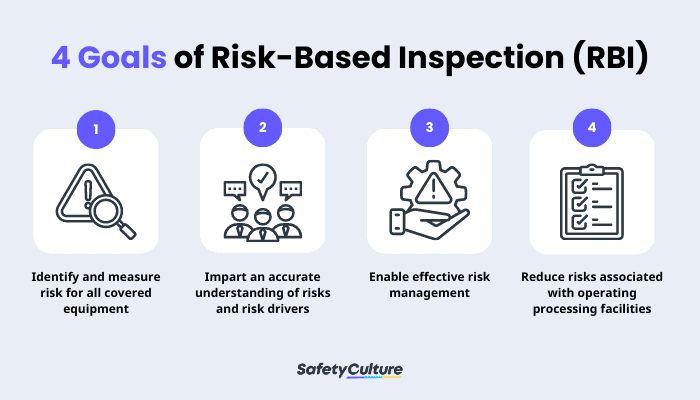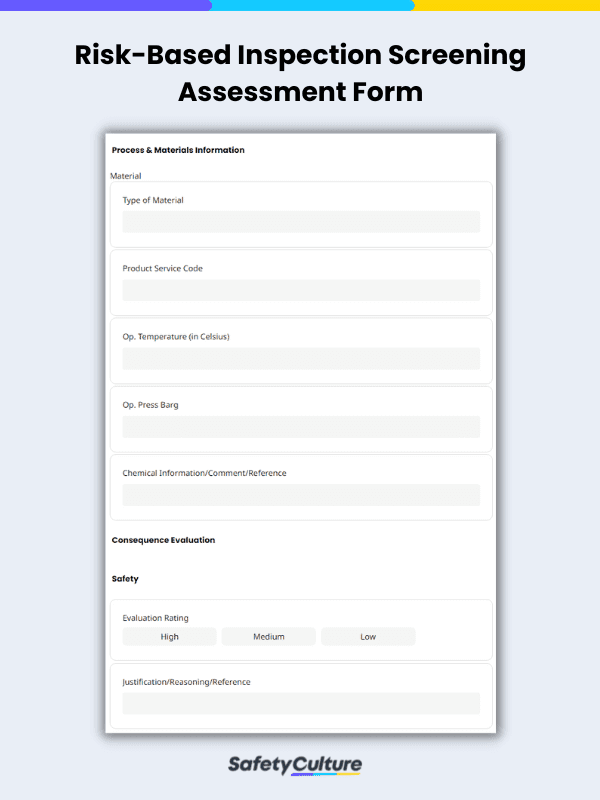What is a Risk-based Inspection (RBI)?
Risk-based inspection (RBI) is a risk assessment and management approach that aims to develop an optimal routine inspection scheme based on risk knowledge associated with equipment and structural items. It serves as an alternative strategy to Class rule-based or time-based inspection regimes.
How Does It Work?
During the risk-based inspection process, engineers conduct a qualitative, quantitative, or semi-quantitative assessment to determine the probability of failure (PoF) and consequence of failure (CoF), then ultimately discern:
- which components to inspect;
- what degradation mechanism to use for inspections;
- when to inspect; and
- how to inspect.
This asset management methodology is predominant in the engineering field, particularly in the Oil and Gas industries. Some of the most common types of assets that undergo risk-based inspection include pressure vessels, atmospheric storage tanks, underground storage tanks, floating offshore installations, pipeline structures, boilers, and power generation components such as steam generators and turbines.
What are the Goals of RBI?
According to the American Petroleum Institute (API), the official trade association for the oil and natural gas industry of the United States, an RBI program has four key goals:

- Identify and measure risk for all covered equipment
- Impart an accurate understanding of risks and risk drivers
- Enable effective risk management
- Reduce risks associated with operating processing facilities
How was RBI Conceived?
Facility and equipment asset maintenance had historically been performed through a time-based inspection (TBI) regime. While the TBI regime proved to be effective in maintaining assets in operational condition over the past decades, its efficiency was challenged by the growing number of equipment and other assets in facilities. This growth needed to be supported by the required inspections, which ballooned expenses due to the related costs and resources needed to conduct the inspections. With this, there was a necessity to rethink TBI schemes and optimize their inspection schedules hence risk-based inspections were conceived.
Why use a Risk-Based Inspection Instead of Time-Based?
The risk-based inspection approach has proven to be a valuable strategy in asset maintenance and regulation compliance, particularly in providing a cost-efficient inspection plan. In a 2018 case study by engineering leads from PinnacleART, four key advantages of RBI over the TBI approach were identified.
Reduced turnaround exposure
With the RBI approach, non-essential checks in the inspection program can be identified and removed from the scope to achieve efficiency. With these exclusions, total inspection times and manpower needs are reduced, thus helping optimize inspection processes.
Extended Inspection Intervals
In addition to overall risk reduction and promoting a safer work environment, RBI plans also help in cost reductions. Risk-based inspections identify equipment that either does not require servicing or needs only minor evaluations. This way, inspection and maintenance activities become cost-effective and flexible with regard to planning and scheduling. Risk-based inspections result in a significant reduction in the frequency, and duration of each individual inspection. This produces a more concentrated, accurate data set.
Increased Operational Awareness
The risk-based inspection framework can help increase operational knowledge and make collaboration easier. As a result of the continuous interaction between corrosion and inspection engineers, including regular discussions on the effects of operating conditions on equipment damage and susceptibilities, operations personnel become more knowledgeable about the entire process, resulting in a natural increase in accountability.
Optimized Inspection Regimes
An RBI program provides the justification to eliminate ineffective, unnecessary, or excessive inspection techniques. It provides a basis for the reduction or elimination of inspection activities in low-risk assets that are not deemed dangerous enough to negatively impact operations.
What are the Recommended Practices for Risk-based Inspections?
The API published recommended practices for risk-based inspections through API RP 580, Risk-Based Inspection, Third Edition and the API RP 581, Risk-Based Inspection Methodology.
API RP 580, published in 2002, is the cardinal document that provides the fundamentals on how to develop, implement, and maintain a credible RBI program. It serves as the criterion for the level of quality that RBI programs need to comply with. It also answers the questions:
- What is RBI?
- What are the key elements of RBI?
- How do I implement an RBI program?
API RP 581, published in 2016, supplements the minimum provisions of API RP 580 and provides quantitative RBI methods that define risk as the combination of POF and COF.


